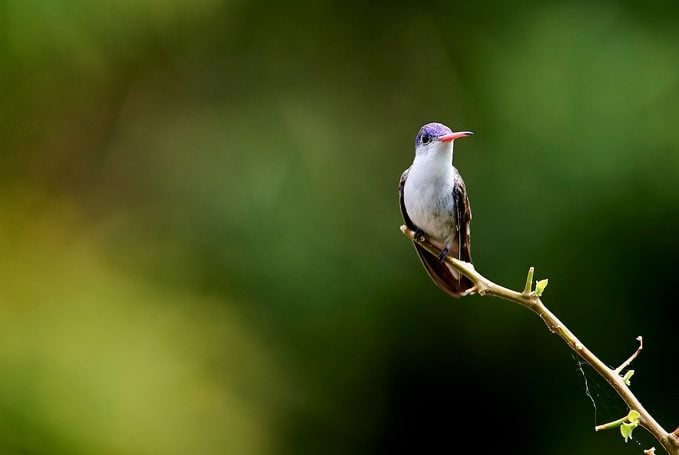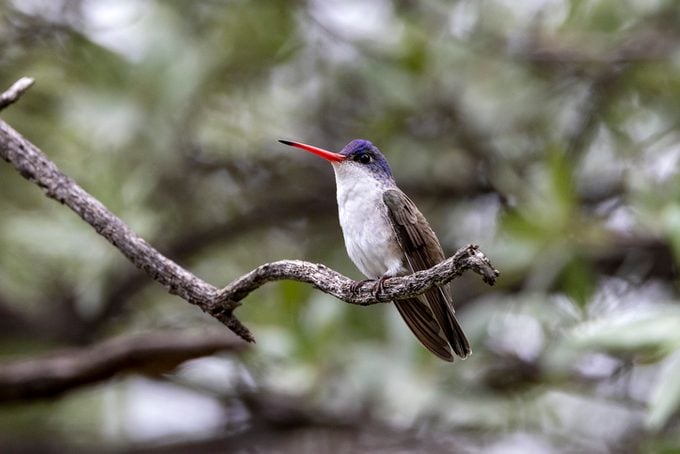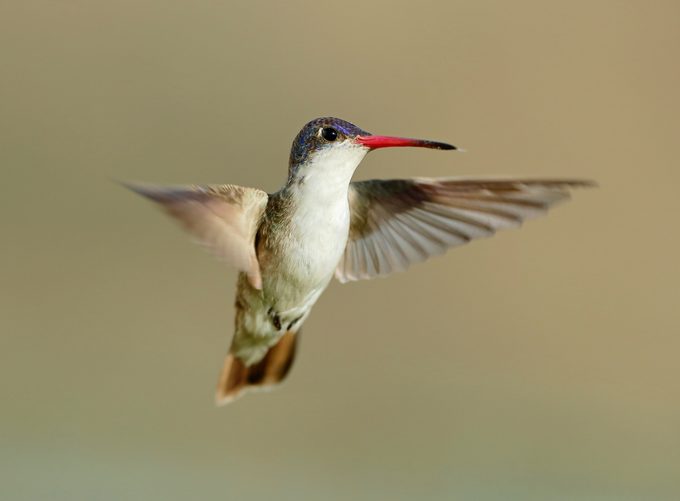See a Violet-Crowned Hummingbird in the Southwest
Updated: Jan. 10, 2024
Look for a violet-crowned hummingbird in Arizona and New Mexico. Learn what this bird looks like, what they sound like and where they nest.
On This Page
What Does a Violet-Crowned Hummingbird Look Like?

Both male and female violet-crowned hummingbirds measure about 4 inches with snowy white underparts. No other U.S. hummingbird shares the starkly white unmarked belly, throat, and flanks. The bronze-greenish back can appear grayish under some light conditions.
The crown, nape, and face are purplish, sometimes appearing violet-blue or even more blue than purple, and varying in intensity among individuals. A bright red bill with a black tip adds a splash of color to these striking birds.
Adult males and females are essentially indistinguishable. Females may have a slighter duller-colored crown than males. But there is so much overlap in shading of the crown that plumage alone is not a reliable indicator of sex.
Juveniles are paler, often appearing plain gray above and white below.
Typically about 11 cm in length, the violet-crowned hummingbird is one of the largest hummers found in the U.S. It is noticeably larger than other species that are common in southernmost Arizona and New Mexico, such as the broad-billed and black-chinned hummingbird. However, it is smaller than the Rivoli’s hummingbird and blue-throated mountain-gem.
How to Attract Violet-Crowned Hummingbirds
Violet-crowns feed on nectar from many different plants, especially those with bright-colored tubular flowers.
If you live within their range, consider planting species that are native to the region, including various species of red salvia, firecracker bush (Bouvardia ternifolia), scarlet betony (Stachys coccinea) and bat-faced cuphea. These hummingbirds also feed on agave flowers and various flowering trees. When landscaping, always try to leave native plants and native plant communities intact.
These birds also readily come to feeders.
Violet-Crowned Hummingbird Range

Primarily a Mexican species, the violet-crowned hummingbird reaches the northern limit of its range in extreme southeast Arizona and adjacent southwest New Mexico. Its presence in the U.S. is relatively recent, with the first recorded nesting north of Mexico confirmed in 1959.
Increasingly the violet-crowned hummingbird is both nesting in and overwintering within its narrow range in Arizona and New Mexico, perhaps due the prevalence of hummingbird feeders.
The birds do not occur in Texas or California except as very rare vagrants, with just a few records for those two states.
Learn how to identify a Costa’s hummingbird.
Migration

In the northern part of their range, violet-crowned hummers are considered at least partially migratory.
Little is known of their migratory habits, but the breeding season runs from April into August. Northward migration occurs primarily in late winter and early spring and southward migration occurs from mid-summer through mid-autumn.
Migrating birds reach their U.S. range by the first half of June and depart in August and September. However, some individuals arrive earlier and stay later or even all year.
Some seem to partake in migration-like “wandering” outside of the breeding season. Individuals can show up nearly any time within or close to the expected range.
Do hummingbird sightings have special meaning?
Hummingbird Hotspot
The easiest, most reliable location to observe a violet-crowned hummingbird is at the Tucson Audubon’s Paton Center for Hummingbirds in Patagonia, Arizona.
According to the Paton Center, more people have first laid eyes on this species at this location than anywhere else on the planet. In recent years, a small number birds have been observed overwintering there.
For information, visit www.tucsonaudubon.org/paton-center/.
Check out jaw-dropping facts about hummingbirds.
Violet-Crowned Hummingbird Nest
This species is generally riparian. According to the Cornell Lab of Ornithology, almost all nests in Arizona and New Mexico are found some 20 to 40 feet above ground in sycamore trees.
Most observed nests are constructed of whitish cotton-like down plant material bound with spiderwebs and camouflaged with lichen and other plant debris. The cup shape and its construction is similar to other hummingbird nests.
There is virtually no data on violet-crowned hummingbird nesting behavior. For most hummingbird species, eggs hatch in 14 to 19 days. Young fledge in about 3 to 3 1/2 weeks.
Find out why hummingbirds are the ultimate bird supermoms.
Violet-Crowned Hummingbird Song
Listen for their song of soft but piercing high-pitched notes, cheer-cheeer-cheeer-cheeer-cheeer. Calls, especially at dawn, include a kissing chip-chip-chip.
Little is known about its courtship behavior. No displays have been recorded other than persistent singing, presumably by males on conspicuous perches.
Learn more about the many sounds of hummingbirds.
Bird songs courtesy of the Cornell Lab of Ornithology.
Behavior
Violet-crowned hummingbirds will actively chase away other species, especially in the absence of multiple nectar sources. They can dominate smaller species. They often select a favorite perch to use routinely.
Why Trust Us
For nearly 30 years, Birds & Blooms, a Trusted Media Brand, has been inspiring readers to have a lifelong love of birding, gardening and nature. We are the #1 bird and garden magazine in North America and a trusted online resource for over 15 million outdoor enthusiasts annually. Our library of thousands of informative articles and how-tos has been written by trusted journalists and fact-checked by bird and garden experts for accuracy. In addition to our staff of experienced gardeners and bird-watchers, we hire individuals who have years of education and hands-on experience with birding, bird feeding, gardening, butterflies, bugs and more. Learn more about Birds & Blooms, our field editor program, and our submission guidelines.
Sources
- The Hummingbird Handbook: Everything You Need to Know About These Fascinating Birds
- Tucson Audubon’s Paton Center for Hummingbirds
- Cornell Lab of Ornithology
